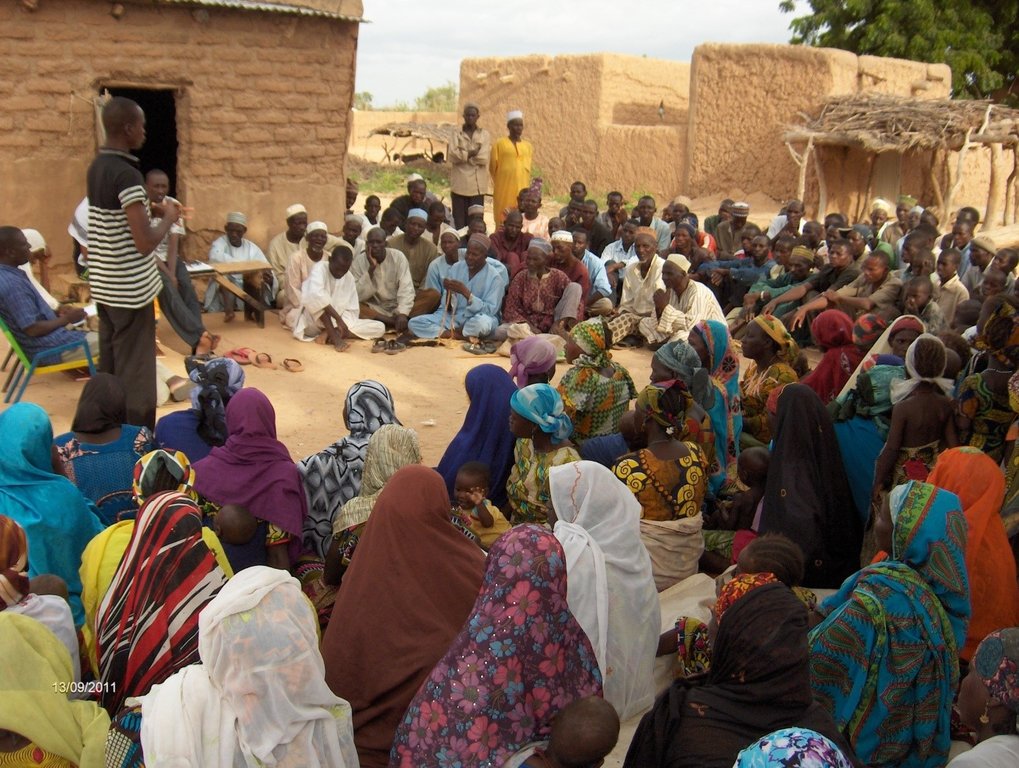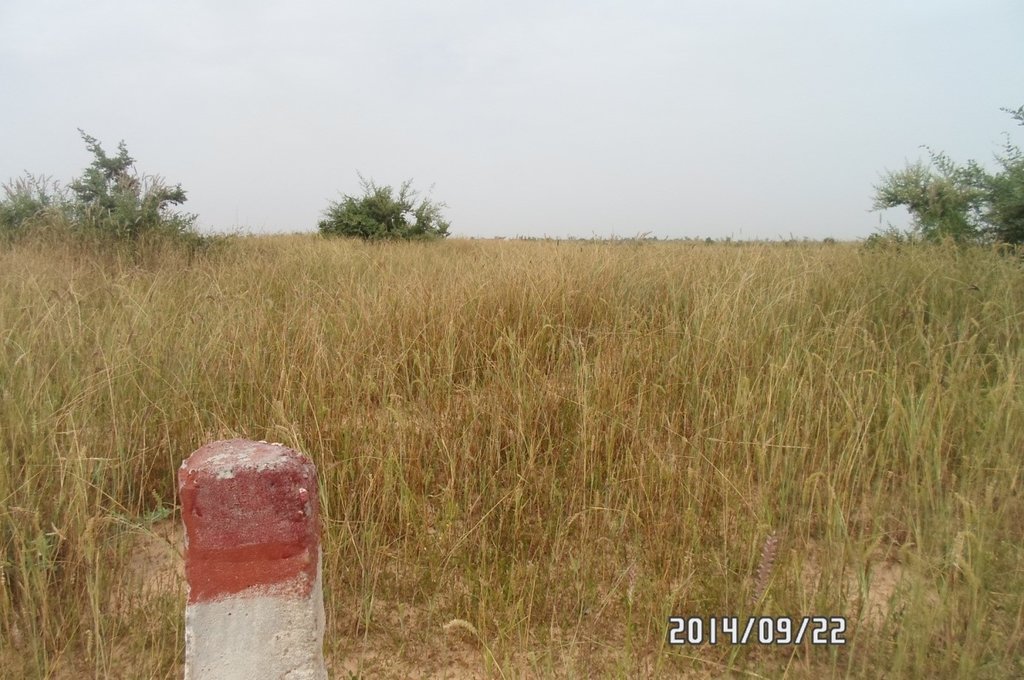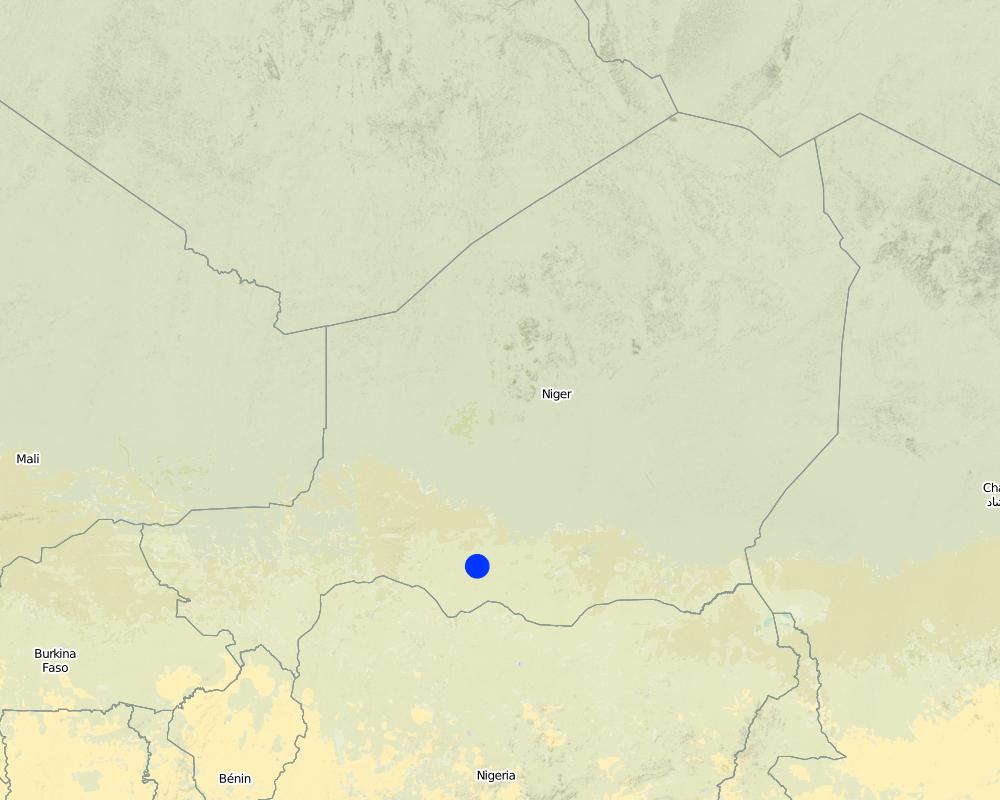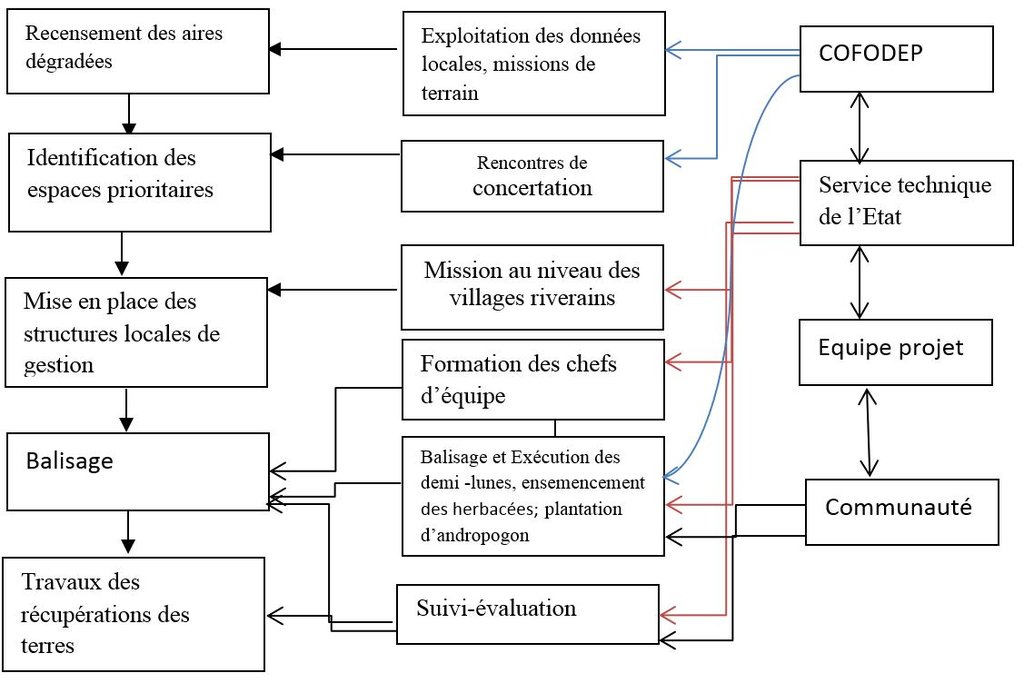Consensus-based management of the rangelands of Guidan Issa (Niger) [Niger]
- Creation:
- Update:
- Compiler: Judith Macchi
- Editors: Christine Lottje, Maman Aicha
- Reviewers: David Beritault, Alexandra Gavilano, Deborah Niggli
Raya dawan gomna Guidan Issa taré da sa hannou doun wanda ya kamata
approaches_690 - Niger
View sections
Expand all Collapse all1. General information
1.2 Contact details of resource persons and institutions involved in the assessment and documentation of the Approach
Key resource person(s)
land user:
Dan Azoumi Wahilou
96 62 72 43 / 98 02 65 22
Agro-pastoralist in Guidan Issa
Agro-pasteur à Guidan Issa
Niger
Name of project which facilitated the documentation/ evaluation of the Approach (if relevant)
Book project: where people and their land are safer - A Compendium of Good Practices in Disaster Risk Reduction (DRR) (where people and their land are safer)Name of the institution(s) which facilitated the documentation/ evaluation of the Approach (if relevant)
HEKS (Hilfswerk der Evangelischen Kirchen Schweiz) (HEKS (Hilfswerk der Evangelischen Kirchen Schweiz)) - Switzerland1.3 Conditions regarding the use of data documented through WOCAT
When were the data compiled (in the field)?
26/10/2016
The compiler and key resource person(s) accept the conditions regarding the use of data documented through WOCAT:
Yes
2. Description of the SLM Approach
2.1 Short description of the Approach
The consensus-based management of the area of Guidan Issa consists of rehabilitating this resource for agro-pastoral livelihoods in a participatory and inclusive way, by considering the various actors involved in the exploitation and management of this rangeland area.
2.2 Detailed description of the Approach
Detailed description of the Approach:
The population of the department of Mayahi is predominantly agro-pastoral. The two activities of farming and pastoralism take place in the same areas, where the condition of natural resources shows a declining trend. An increase in the size of the population and the number of livestock is observed, which imposes increasing demands on land. The cultivated area continues to increase, and the transhumance of animals becomes an increasingly important activity. The small areas of rangeland which receive these herds are increasingly overloaded, and show obvious signs of degradation. In addition, these rangelands are progressively reduced at the benefit of agricultural land.
In view of this situation, and given the need for action, the communities and the project Zamtapo, with the methodological and financial support from HEKS, initiated and implemented a strategy for consensus-based management of degraded rangelands, among which the rangeland of Guidan Issa, which is the principal rangeland for the village of Guidan Issa (department of Mayahi, rural municipality of Tchaké). The management of this rangeland is based on a participatory and inclusive approach, aiming at a social agreement between all stakeholders.
The activities of the project Zamptapo target only the pastoral land which is recognized and accepted by all the actors to exist since many generations, even before the origin of some villages. The selection of areas to be managed is made by the administrative and customary authorities, and by the delegates of the farmers and ranchers. Cross-community meetings, gathering all probable land users, are organised in the villages surrounding the area of Guidan Issa to ensure the exact demarcation of the area. These meetings also allow to remind the neighbouring populations of the issues regarding this grazing land, and of the advantages of its management.
2.3 Photos of the Approach
2.5 Country/ region/ locations where the Approach has been applied
Country:
Niger
Region/ State/ Province:
Maradi
Further specification of location:
Mayahi, village of Guidan Issa
Map
×2.6 Dates of initiation and termination of the Approach
Indicate year of initiation:
2014
2.7 Type of Approach
- project/ programme based
2.8 Main aims/ objectives of the Approach
- Reduce conflicts
- Share experience
2.9 Conditions enabling or hindering implementation of the Technology/ Technologies applied under the Approach
availability/ access to financial resources and services
- hindering
The land users do not have access to resources and financial services because they are poor. The labor, seed, fencing, equipment and training are covered by the project.
legal framework (land tenure, land and water use rights)
- enabling
Knowledge of the land tenure system and rights to use land and water.
land governance (decision-making, implementation and enforcement)
- enabling
Decision support and implementation of decisions.
markets (to purchase inputs, sell products) and prices
- enabling
Availability of equipment and seed.
workload, availability of manpower
- enabling
The work unrolls with ease because manpower is available.
3. Participation and roles of stakeholders involved
3.1 Stakeholders involved in the Approach and their roles
- local land users/ local communities
Local land users
Provide labor
- SLM specialists/ agricultural advisers
Departmental land commission, Environmental service, Agricultural engineering service
Provide technical expertise with regard to the delimitation of the area, fencing and seeding.
- NGO
HEKS
Finances the activities and capacity building and provides methodological support.
- local government
Municipal council
The mayor and the municipal counselors schedule the activities of the municipality in the annual investment plan (PIA) and the municipal development plan (PDC).
Le maire et les conseillers municipaux planifient les activités de la commune dans le plan d'investissement annuel (PIA) et le plan de développement communal (PDC)
If several stakeholders were involved, indicate lead agency:
NGO HEKS
3.2 Involvement of local land users/ local communities in the different phases of the Approach
| Involvement of local land users/ local communities | Specify who was involved and describe activities | |
|---|---|---|
| initiation/ motivation | interactive | Local land users, the departmental land commission and the project team. Meetings to inform and to raise awareness on the importance of rehabilitating the area. |
| planning | interactive | Local land users, the municipal council, the departmental land commission and the project team. Planning of activities and prior identification of the area to rehabilitate. |
| implementation | external support | Local land users, the departmental land commission and the project team. Land rehabilitation work. |
| monitoring/ evaluation | interactive | Local land users, the departmental land commission and the project team. Monitoring of the work during the implementation. |
3.3 Flow chart (if available)
Description:
Diagram of the implementation of the approach.
<Translations of the text boxes:
Recensement des aires dégradées: Inventory of degraded areas
Identification des espaces prioritaires: identification of priority areas
Mise en place des structures locales de gestion: implementation of sustainable land management measures
Balisage: fencing
Travaux des récupérations des terres: Land rehabilitation work
Exploitations des données locales, mission de terrain: Capturing of local data, field visits
Rencontres de concertation: Consultation meetings
Mission au niveau des villages riverains: mission to the neighboring villages
Formation des chefs d'équipe: training of team leaders
Balisage et exécution des demi-lunes, ensemencement des herbacées, plantation d'andropogon: Fencing and construction of semi-circular bunds, seeding of herbaceous plants, planting of Adropogon gayanus.
Suivi-évaluation: monitoring and evaluation
Service technique de l'Etat: Technical service of the State/National technical service
Equipe projet: project team
Communauté: community>
3.4 Decision-making on the selection of SLM Technology/ Technologies
Specify who decided on the selection of the Technology/ Technologies to be implemented:
- all relevant actors, as part of a participatory approach
Explain:
The decision making for the selection of the technology has been done in a participatory way with all the actors concerned. Missions for identification have been performed, discussion groups have been organised. The whole process was focused on obtaining social agreements.
Specify on what basis decisions were made:
- evaluation of well-documented SLM knowledge (evidence-based decision-making)
4. Technical support, capacity building, and knowledge management
4.1 Capacity building/ training
Was training provided to land users/ other stakeholders?
Yes
Specify who was trained:
- land users
If relevant, specify gender, age, status, ethnicity, etc.
60% women and 40% men
Form of training:
- demonstration areas
- public meetings
Subjects covered:
Techniques for the management of degraded land
Non-violent conflict management
Comments:
The land users are in control of the rules for the use and exploitation of the common resources.
4.2 Advisory service
Do land users have access to an advisory service?
Yes
Specify whether advisory service is provided:
- on land users' fields
Describe/ comments:
The land commissions and the environmental services support the land users in implementing techniques for sustainable land management in the area where the work is carried out.
4.3 Institution strengthening (organizational development)
Have institutions been established or strengthened through the Approach?
- yes, a little
Specify the level(s) at which institutions have been strengthened or established:
- local
- regional
- national
Describe institution, roles and responsibilities, members, etc.
The COFO derives from the Rural Code. This institution is charged with the control and management of natural resources at the local level. The COFO constitutes a framework for agreement, reflection and decision making on the prevention of conflicts related to natural resources. The COFO has the following roles:
- Making the population aware of the measures that can be taken to manage the natural resources;
- Identification and demarcation of the community grounds;
- Ensuring compliance with the demarcated community grounds;
- Issuing of land titles.
The members of the land commissions are representatives of all the social and professional groups (farmers, ranchers, technical services, etc.)
Specify type of support:
- capacity building/ training
- equipment
Give further details:
The land commissions received several trainings, support and equipment to improve their functioning.
4.4 Monitoring and evaluation
Is monitoring and evaluation part of the Approach?
Yes
Comments:
The community, the municipal council and the Zamtapo project carry out the monitoring and evaluation.
If yes, is this documentation intended to be used for monitoring and evaluation?
No
4.5 Research
Was research part of the Approach?
No
5. Financing and external material support
5.1 Annual budget for the SLM component of the Approach
If precise annual budget is not known, indicate range:
- 10,000-100,000
Comments (e.g. main sources of funding/ major donors):
Financed by the NGO HEKS EPER
5.2 Financial/ material support provided to land users
Did land users receive financial/ material support for implementing the Technology/ Technologies?
Yes
If yes, specify type(s) of support, conditions, and provider(s):
Compensation payments for labor (cash for work)
5.3 Subsidies for specific inputs (including labour)
- labour
| To which extent | Specify subsidies |
|---|---|
| fully financed | Financed by the Zamtapo project |
- equipment
| Specify which inputs were subsidised | To which extent | Specify subsidies |
|---|---|---|
| tools | fully financed | Financed by the Zamtapo project |
- agricultural
| Specify which inputs were subsidised | To which extent | Specify subsidies |
|---|---|---|
| seeds | partly financed | 75% financed by the Zamtapo project, 25% covered by the community |
If labour by land users was a substantial input, was it:
- paid in cash
Comments:
Labor was used for the land management work (construction of semi-circular bunds and seeding). The labor was paid in cash after the work.
5.4 Credit
Was credit provided under the Approach for SLM activities?
No
5.5 Other incentives or instruments
Were other incentives or instruments used to promote implementation of SLM Technologies?
No
6. Impact analysis and concluding statements
6.1 Impacts of the Approach
Did the Approach empower local land users, improve stakeholder participation?
- No
- Yes, little
- Yes, moderately
- Yes, greatly
The approach has improved the participation of stakeholders and strengthened their particular roles.
Did the Approach enable evidence-based decision-making?
- No
- Yes, little
- Yes, moderately
- Yes, greatly
The approach is based on clear and precise explanations of sustainable land management, which lead to acceptance by all actors.
Did the Approach help land users to implement and maintain SLM Technologies?
- No
- Yes, little
- Yes, moderately
- Yes, greatly
Throughout the approach, the land users obtained a good understanding of the issues in sustainable land management.
Did the Approach mobilize/ improve access to financial resources for SLM implementation?
- No
- Yes, little
- Yes, moderately
- Yes, greatly
The NGOs raised funds for the implementation of the sustainable land management measures.
Did the Approach improve knowledge and capacities of land users to implement SLM?
- No
- Yes, little
- Yes, moderately
- Yes, greatly
Through training and awareness raising on sustainable land management.
Did the Approach improve knowledge and capacities of other stakeholders?
- No
- Yes, little
- Yes, moderately
- Yes, greatly
The approach has fostered the exchange between the different groups of actors.
Did the Approach build/ strengthen institutions, collaboration between stakeholders?
- No
- Yes, little
- Yes, moderately
- Yes, greatly
The approach has created conditions of agreement and understanding among all stakeholders.
Did the Approach mitigate conflicts?
- No
- Yes, little
- Yes, moderately
- Yes, greatly
The approach mitigated conflicts because it took account of the interests of all concerned actors.
Did the Approach improve gender equality and empower women and girls?
- No
- Yes, little
- Yes, moderately
- Yes, greatly
The approach improved gender equality and empowered women and girls, because it is based on gender equality, and promotes gender as an important aspect.
Did the Approach encourage young people/ the next generation of land users to engage in SLM?
- No
- Yes, little
- Yes, moderately
- Yes, greatly
In the approach, young people were considered as key actors for implementing the sustainable land management.
Did the Approach improve issues of land tenure/ user rights that hindered implementation of SLM Technologies?
- No
- Yes, little
- Yes, moderately
- Yes, greatly
Through sessions to raise awareness on the rights to access and use natural resources.
6.2 Main motivation of land users to implement SLM
- increased production
The increase in the production of forage is one of the main motivations for farmers to implement sustainable land management measures.
- reduced land degradation
Due the decreasing soil fertility, the potential for livestock farming has declined. This explains the need for sustainable land management.
- enhanced SLM knowledge and skills
The degradation of arable and grazing land due to the harmful effects of climate change has made land users aware of the need for sustainable land management. This explains their interest in improving their knowledge and skills in this domain.
- conflict mitigation
The increase of the population and the number of livestock has caused conflicts on land between land users. This has motivated the various actors for sustainable land management, with the intention to mitigate conflicts.
6.3 Sustainability of Approach activities
Can the land users sustain what has been implemented through the Approach (without external support)?
- yes
If yes, describe how:
The land users are able to continue their activities. For example, the seed collected on the treated area was used for seeding other degraded areas on the initiative of the same community.
6.4 Strengths/ advantages of the Approach
| Strengths/ advantages/ opportunities in the land user’s view |
|---|
| - Conflict mitigation |
| - Enforcement of rules and regulations |
| - Improvement of knowledge and skills in sustainable land management |
| Strengths/ advantages/ opportunities in the compiler’s or other key resource person’s view |
|---|
| The approach is easy to implement. |
| The approach is sustainable and based on consensus. |
6.5 Weaknesses/ disadvantages of the Approach and ways of overcoming them
| Weaknesses/ disadvantages/ risks in the land user’s view | How can they be overcome? |
|---|---|
| - Hesitance of the land users to participate in the beginning of the implementation of the approach. | - Awareness raising in cross-community discussion groups with all concerned actors. |
| - The approach is difficult to implement without support from funding agents. | - Fund raising with the support from the local, regional and national governments. |
| Weaknesses/ disadvantages/ risks in the compiler’s or other key resource person’s view | How can they be overcome? |
|---|---|
| - Ignorance of texts and laws regulating pastoralism. | - Translation of texts in the local languages and extension. |
| - Hesitance of land users to participate in the beginning of the implementation of the approach. | - Informing stakeholders and awareness raising. |
| - The approach is difficult to implement without support from funding agents. | - Fund raising. |
7. References and links
7.1 Methods/ sources of information
- field visits, field surveys
45
- interviews with land users
20
Links and modules
Expand all Collapse allLinks
No links
Modules
No modules






